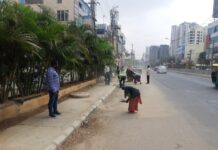b | a | n | d | i | n | i
constitution club | new delhi
18th january 2019 | 10 am onwards
Dear friends
Over the past 15 years, India’s jails have seen a rise in women inmates by 61%. However, they are only 4.3% of the national population and thus hardly raise any red flags in the larger scheme of things. Women in Indian jails are not a major policy concern for the State. For decades, they have suffered the lack of basic infrastructure, health care, vocational training and humane treatment. A larger cultural understanding of criminality dictates that crime is masculine in nature. Thus, any women who dare to perform this masculinity deserve to be dehumanised and made to be invisible. From the report of women in prisons published on June 2018, by the Ministry of Women and Child Development ‘A majority of female inmates are in the age group of 30-50 years (50.5%), followed by 18-30 years (31.3%). Of the total 1,401 prisons in India, only 18 are exclusive for women, housing 2,985 female prisoners.Thus, a majority of women inmates are housed in women’s enclosures of general prisons.’
From custodial torture, rape, denial of health services, lack of clean food and water and a sheer ignorance on behalf of the state, the Indian prison has failed to respect the rights of the inmates. Various studies done within Indian prisons have always concluded that majority of prisoners come from Adivasis, Dalits and other marginalised communities are being criminalised. Their social and economic backwardness makes them vulnerable, being not being able to defend themselves legally and financially. They are targeted by the State more than citizens belonging to upper caste upper class gentry. This then brings into question the role of the prison, the State and their goal when it comes to countering crime. Crime by definition means the gross violation of law, the subjectivity of the act of crime requires investigation, and judicial intervention. But as many reports have found, a majority of confessions from prisoners who come from socially and economically underprivileged background are forced out of them through torture and blackmail.
In such cases, fundamental rights and basic human rights are flouted openly. In colonial era jails, Indian women who fought for the country’s freedom were thrown in jails to languish for years before they were let out. In those times, women being thrown into jail had two very important consequences. First, it was the fact that women were no longer being viewed as docile and submissive citizens of the country, the authorities had a new wave of people to contend with and secondly, women were able to join this to the larger fight of equality with men. Their participation in the freedom struggle and facing the same hardships as their male counterparts was a huge blow to gender norms and prescriptive roles that women were expected to play.
It is important to note that the struggles to protect the land, water and forests led by women across India is resisting the anti-people policies unleashed by the governments. While actively resisting these inhuman model of development, the women are implicated in fabricated cases forged by the ‘protectors’ of law and order. Today, thousands of women are wasting away in jails, not being treated like humans, held over false cases, being raped and tortured by police officials, and most of them belong to underprivileged sections of the society. Women who have been active in the forefront of protecting the natural resources have been falsely implicated in cases by the police of each state respectively. Activists like Soni Sori and Sudha Bharadwaj, forest rights activists like Sukalo Gond, Rajkumari, Kismatiya, Sobha of All India Union of Forest Working Peoples, women from Narmada Bachao Andolan women in Kudankulam, Adivasi women of Chhattisgarh, Odisha [with specific reference to Niyamgiri], cultural activist like Sheetal Sathe etc are among many who are continued to be persecuted by the State on a daily basis. This state of affairs needs to be examined in the light of the way in which governmentality is being thrusted upon people who work with the Adivasis, Dalits and marginalised communities struggling for their survival.
In this context, a public hearing is planned to be held on January 18th, 2019 at the Constitution Club of India, New Delhi by the All India Union of Forest Working People and Delhi Solidarity Group. Various women activists who have been falsely implicated and have been languishing in jails will address the hearing along with human rights lawyers, academicians and civil society leaders will be part of the public hearing. This public hearing is also initiated in memory of Bharti Roy Chaudhary who was a pioneer in raising Women Forest and Land Rights movement as a founding member of National Forum of Forest Working People [NFFPFW] and Uttar Pradesh Land Right and Labour Rights Campaign Committee.
Notes
The number of women and girls in prison have increased by 50 percent in the past 15 years. India too has seen an increase in population of women prisoners. With a population of 11094, women inmates formed 3.5 percent of prison population in 2001. 15 years later, Indian prisons house 17834 women inmates, an increase of 61 percent. Therefore their share in prison population has gone up to 4.3 percent. In the last decade, 477 women inmates have died inside prison. [CHRI Report 2015]
In solidarity
Ashok Choudhary, Roma [All India Union of Forest Working People]
Anil Tharayath Varghese [Delhi Solidarity Group]









